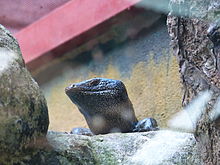Dotted galliwasp
| Dotted galliwasp | |
|---|---|
 | |
| Scientific classification | |
| Domain: | Eukaryota |
| Kingdom: | Animalia |
| Phylum: | Chordata |
| Class: | Reptilia |
| Order: | Squamata |
| Family: | Diploglossidae |
| Genus: | Diploglossus |
| Species: | D. millepunctatus |
| Binomial name | |
| Diploglossus millepunctatus O'Shaughnessy, 1874 | |
The dotted galliwasp or Malpelo galliwasp (Diploglossus millepunctatus) is a carnivorous species of lizard endemic to Malpelo Island, Colombia.[2]
Description
[edit]Adults of the species grow to 50 cm in total length and can reach a weight of 500 g. They are predominantly black, but are liberally dotted with white.
Diet
[edit]D. millepunctatus has extremely odd feeding habits for a lizard. Malpelo Island has few resources; the only available foods are crabs and seabirds, especially boobies. While the lizards eat both of these, they also eat guano, and mob birds returning to their young, forcing them to regurgitate their food for the lizards instead of their chicks.[3]
Breeding
[edit]D. millepunctatus is viviparous.[2]
Habitat
[edit]The species is endemic to Malpelo Island, a possession of Colombia, where it is common. The island is treeless, rocky, and very small. Similar to the marine iguana, it has the ability to swim for short distances, although this is not related to its feeding habits. It shares the island with two other endemic lizard species, Anolis agassizi and Phyllodactylus transversalis.[4]
References
[edit]- ^ Bolívar, W.; Castañeda, M.R.; Gutiérrez-Cárdenas, P.; Velasco, J. (2015). "Diploglossus millepunctatus". IUCN Red List of Threatened Species. 2015: e.T44579631A115389226. Retrieved 16 December 2021.
- ^ a b Diploglossus millepunctatus at the Reptarium.cz Reptile Database. Accessed 30 April 2017.
- ^ Cogger, Harold G.; Gould, Edwin; Forshaw, Joseph (1993). Encyclopedia of Animals: Mammals, Birds, Reptiles, Amphibians. Fog City Press. ISBN 978-1-876778-72-9.
- ^ Graham, Jeffrey B. (1975). "The biological investigation of Malpelo Island, Colombia" (PDF). Smithsonian Contributions to Zoology. 176 (176): 1–98. doi:10.5479/si.00810282.176.


 French
French Deutsch
Deutsch